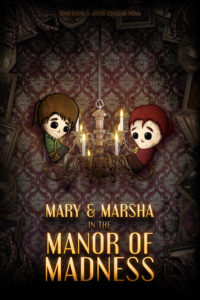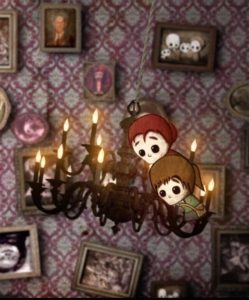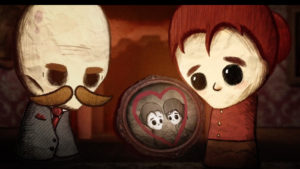Showcase Filmmaker Spotlight: Kurtis and Kris Theorin
Showcase Filmmaker Spotlight: Kurtis and Kris Theorin
By Travis Trew, Programming Associate
Brothers and Landenberg, PA natives Kurtis and Kris Theorin have collaborated on various video projects through family-operated company Something’s Awry Productions, with Kurtis (24) usually writing scripts and Kris (20) handling the animations. The brothers have worked on both commercial projects (for clients including Disney, Warner Bros., and LEGO) and a number of award-winning short films. Mary & Marsha in the Manor of Madness is a hand-drawn and digitally animated “one-shot” film about two girls escaping a very spooky old house, and is inspired both by the horror tales of H.P. Lovecraft and the wacky chase sequences of Scooby-Doo.
PFS: How did you each get into filmmaking?

Kurtis: I got into filmmaking by making silly home movies because that is what Jason from the comic strip FoxTrot did. It turned out to be a lot of fun and I even got some people to laugh. Filmmaking seemed like a much easier way to tell stories than my previous plan of becoming an author. A few years later my brother Kris started making stop-motion animated videos with Lego bricks. We found that our skills were very complimentary and we have been doing bigger and bigger projects ever since.

Kris: The little films Kurtis would make with our Legos really inspired me to do the same. But it was really watching these amazing-looking Lego stop motion films on YouTube that got me into it full time. The idea of taking these everyday kids toys and making a little story out of them was too good to pass up (especially when it allowed a ten-year-old to make Lego Star Wars films).
PFS: Could you walk me through the process of writing and making one of your short films? How does the collaborative process work?
Kurtis: We usually have a reason for making one of our films: some sort of project, we want to show off a skill for our reel, or Kris wants to practice using a new technology. For Mary & Marsha, Kris wanted to practice his 2D animation work, and he had to do a final short film project for one of his classes. Our process starts with me writing a script. I show it to Kris. Kris reminds me that he is only human, he is on a deadline, and seriously, could I please not make it so weird. I revise until he is satisfied. He goes off and somehow animates the entire thing in an astoundingly short period of time. My mom and I review it and point out changes he can do to make the story more effective. Spirited debate ensues. Eventually a better version of the film emerges on the other side and we get our go-to composer Nick Angeloni to score it.
Kris: My end of the process is mainly focused on a few aspects of pre-production (storyboarding, drawing, designing, and just generally figuring out the flow of the short). Where I mainly come in is with production and post-production (animating, editing, VFX, sound design, etc.). Each of us has some amount of influence in the other’s creative process. I’ll provide notes on the scripts and Kurtis will provide notes on the edits. By now, it’s a fairly streamlined process. That being said, the nature of this sort of animation—and my own personal work habits—means that few will actually see the animation until the first cut is done. So for the whole production of these animations, I’m entirely on my own where animating is concerned.
PFS: What’s it like working on something for a client versus something like Mary & Marsha?
Kurtis: The differences are what you would expect. There are less specifications about what we can and can’t do, we don’t have to get things approved by others, and we can be more out-there. The actual day-to-day work is pretty similar though, at least on my end.
Kris: While it can be incredibly fun working on a different project for a client week to week, a project like Mary & Marsha is a refreshing break from all that. The biggest difference here is that we’re both creating a world from scratch. We’re also creating a work that is far more cinematic than anything we’ve done for our commercial work. Suddenly, I find myself focusing on creating cinematic scenes and a cohesive aesthetic, rather than just creating an enjoyable 30-second spot.
 PFS: You’ve described the film as being influenced by both H.P. Lovecraft and cartoons like Scooby-Doo. What drew you to each of those references, and what inspired you to bring them together?
PFS: You’ve described the film as being influenced by both H.P. Lovecraft and cartoons like Scooby-Doo. What drew you to each of those references, and what inspired you to bring them together?
Kurtis: I was looking for a setting I knew both Kris and I enjoyed and Lovecraft fit the bill. I like the strangeness, gothic dread, and mystery in that style of horror. In terms of Scooby-Doo, we’ve used a lot of Saturday morning cartoon antics in our commercial work and I thought it would be really funny to put that in Lovecraftian horror. I like strange or unusual fantasy and whenever strange or unusual fantasy gets a bit dark—as many stories have a tendency to do—it becomes horror.
Kris: H.P. Lovecraft has a very interesting body of work. He’s written an incredibly diverse series of novellas, short stories, and otherwise that lay out a very interesting world. It’s this world that I find to be a perfect backdrop for a number of stories. Of course, the mood in this is nowhere near what Lovecraft would have intended. Instead, we’ve drawn mainly from the energetic and goofy style of the Scooby-Doo cartoons. The marriage of the two came about through a need to tell a story that was both funny and energetic, but also had a sinister undertone. That way, you kind of get the best of both worlds. A few years ago, I would have never seen myself drawn to doing horror related stories. Given that my art style is rather cartoon-y and my animation style is similarly unrealistic, it just didn’t seem like a good fit. However, that seems to be a great combination for my recent work. This allows the shorts to sort of take on a children’s storybook aesthetic. Where the art style seems rather cartoon-y, but the story is often much darker than your average storybook.
PFS: Could you tell me more about the decision to make a “one-shot” chase film, and about the techniques you used to tell the story visually?
Kurtis: The idea was to emulate side-scrolling video games like Castlevania or Metroid where you only view the action from the side as the character makes their way through a large building. We figured that this would give the movie an energetic sense of momentum. It also simplified the animating process which was important since we were on a deadline.
 Kris: The choice to make the film a “one-shot” came about through the nature of this medium. The film was created using a series of flat images arranged in three-dimensional space. That way, we can give the illusion of depth, but not actually have any 3D models. Unfortunately, this means that the camera can’t be moved around that much without revealing just how flat these drawings are. This meant that the film could only really be shot from one angle. Therefore, to avoid ugly jump cuts, we chose to make the whole film in one continuous shot. In order to tell the story visually, we mainly employed a series of dramatic actions that communicate the mood of each scene. For instance, when the father throws the picture of Marsha into the fire, you really understand how he feels about this person.
Kris: The choice to make the film a “one-shot” came about through the nature of this medium. The film was created using a series of flat images arranged in three-dimensional space. That way, we can give the illusion of depth, but not actually have any 3D models. Unfortunately, this means that the camera can’t be moved around that much without revealing just how flat these drawings are. This meant that the film could only really be shot from one angle. Therefore, to avoid ugly jump cuts, we chose to make the whole film in one continuous shot. In order to tell the story visually, we mainly employed a series of dramatic actions that communicate the mood of each scene. For instance, when the father throws the picture of Marsha into the fire, you really understand how he feels about this person.
PFS: The visuals straddle the line between adorable and genuinely creepy. Kris, how did you develop this particular cute-meets-creepy visual style? And can you tell me more about how you designed and executed the visuals?
Kris: I’ve always been a cartoon-y artist. I’m not great at drawing things that are super photorealistic, and I find that the cartoony style is more appealing to an audience. In addition, cartoons are far better for doing animation. I’m a huge fan of the film Coraline, which is a testament to how creepy cute things can be. That was the biggest inspiration in terms of the creep factor for this film. Everything looks very cartoonish, but just slightly off. The visuals were designed mainly for time. I had only a week and a half to design and animate the film. Hence, all the character have no arms, no legs, and no mouths. Plus, all the backgrounds are made up of realistic textures. This allowed the film to be completed on time, and also made it have an aesthetic that was quite unique.
PFS: There’s a really endearing love story between Mary and Marsha at the heart of the movie. Kurtis, how did these particular characters and this storyline come about, and was there a conscious decision to have a queer couple at the center?
 Kurtis: The setting was inspired by a Lovecraft board game called Mansions of Madness where players go into a spooky 1920s house and uncover the cult/ancient relics/murderous beasts that are causing the place to go nuts. Kris and I were both fans of its central idea and aesthetic so I figured it would be fun to do a similar story. The idea of rescuing a loved one then became the obvious but compelling reason for why someone would enter a spooky house. I wanted to make sure that we did not fall into the cliché of the man-rescues-damsel-in-distress trope. This meant that it would either have to be a woman rescuing a man or they were both the same gender. We chose the latter since that felt best for the genre and it’s always good to have underrepresented groups in your fiction. It also had the nice side effect of faking-out the viewers a bit: “Oh you thought her parents locked her away because they didn’t approve of her relationship? Sike! It’s a cult of human sacrifice!” One thing that was very important to me was that both Mary and Marsha felt like they were pulling their weight. Throughout the movie, each one gets a chance to solve the obstacle in their path. That way we see how they rely on each other, which is part of what makes their relationship endearing.
Kurtis: The setting was inspired by a Lovecraft board game called Mansions of Madness where players go into a spooky 1920s house and uncover the cult/ancient relics/murderous beasts that are causing the place to go nuts. Kris and I were both fans of its central idea and aesthetic so I figured it would be fun to do a similar story. The idea of rescuing a loved one then became the obvious but compelling reason for why someone would enter a spooky house. I wanted to make sure that we did not fall into the cliché of the man-rescues-damsel-in-distress trope. This meant that it would either have to be a woman rescuing a man or they were both the same gender. We chose the latter since that felt best for the genre and it’s always good to have underrepresented groups in your fiction. It also had the nice side effect of faking-out the viewers a bit: “Oh you thought her parents locked her away because they didn’t approve of her relationship? Sike! It’s a cult of human sacrifice!” One thing that was very important to me was that both Mary and Marsha felt like they were pulling their weight. Throughout the movie, each one gets a chance to solve the obstacle in their path. That way we see how they rely on each other, which is part of what makes their relationship endearing.
Mary & Marsha in the Manor of Madness will screen on Friday, March 9 at the Prince Theater’s Black Box as part of Philly Film Showcase, an exhibition supporting new work by talented, up-and-coming local filmmakers.